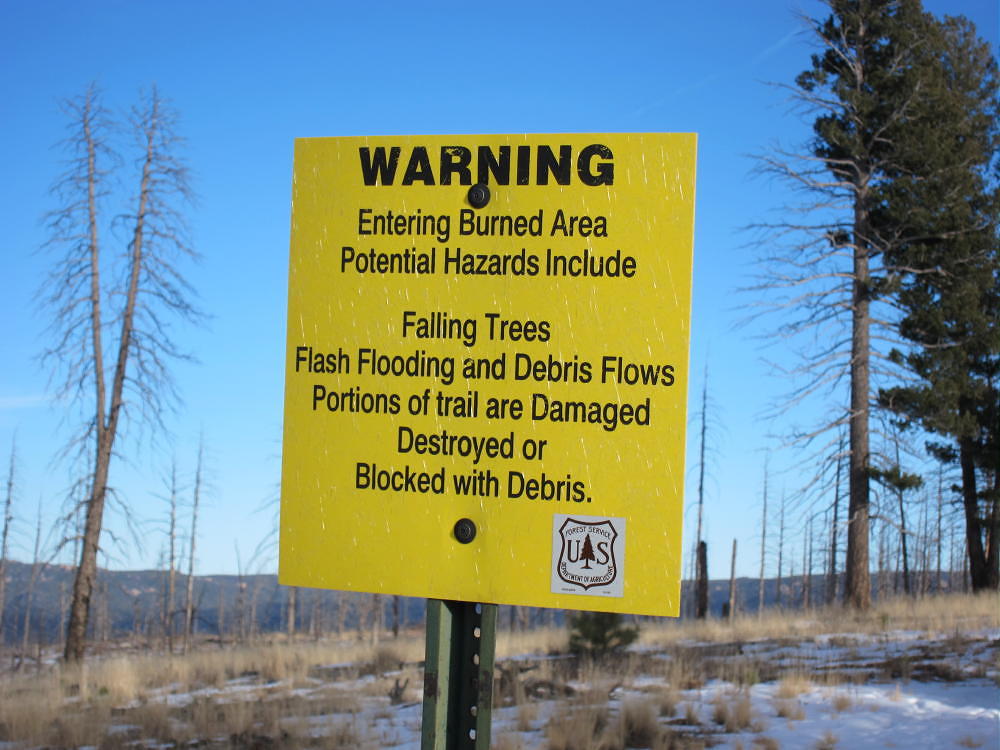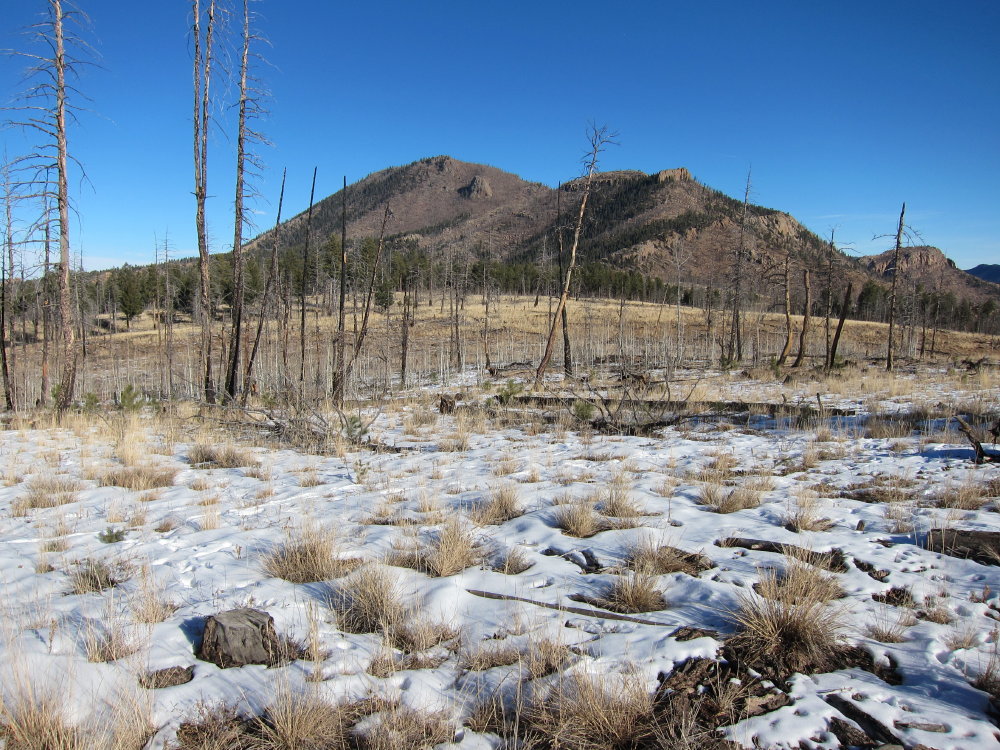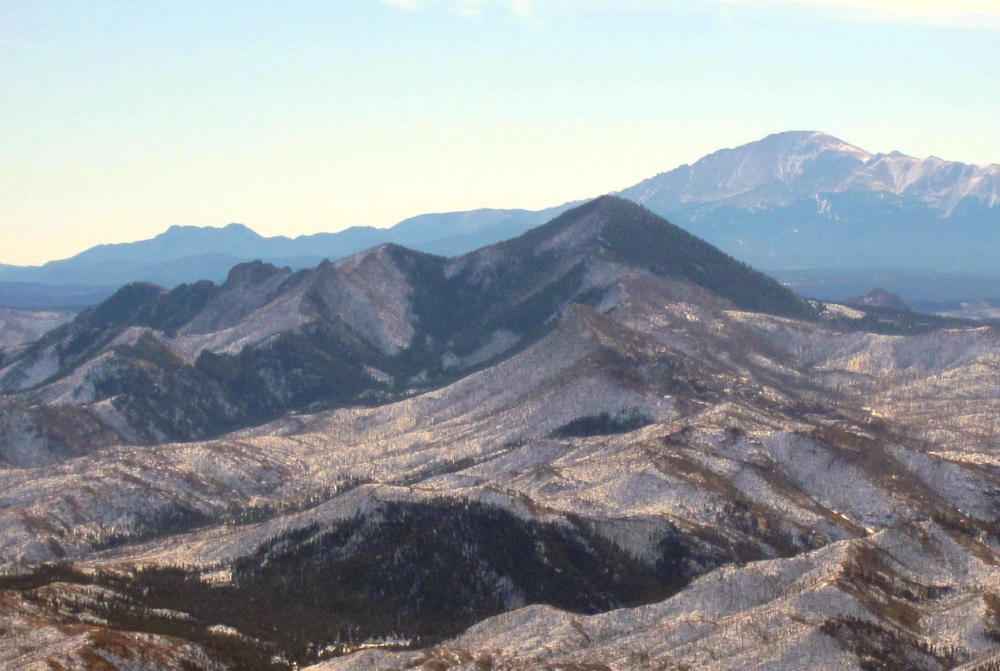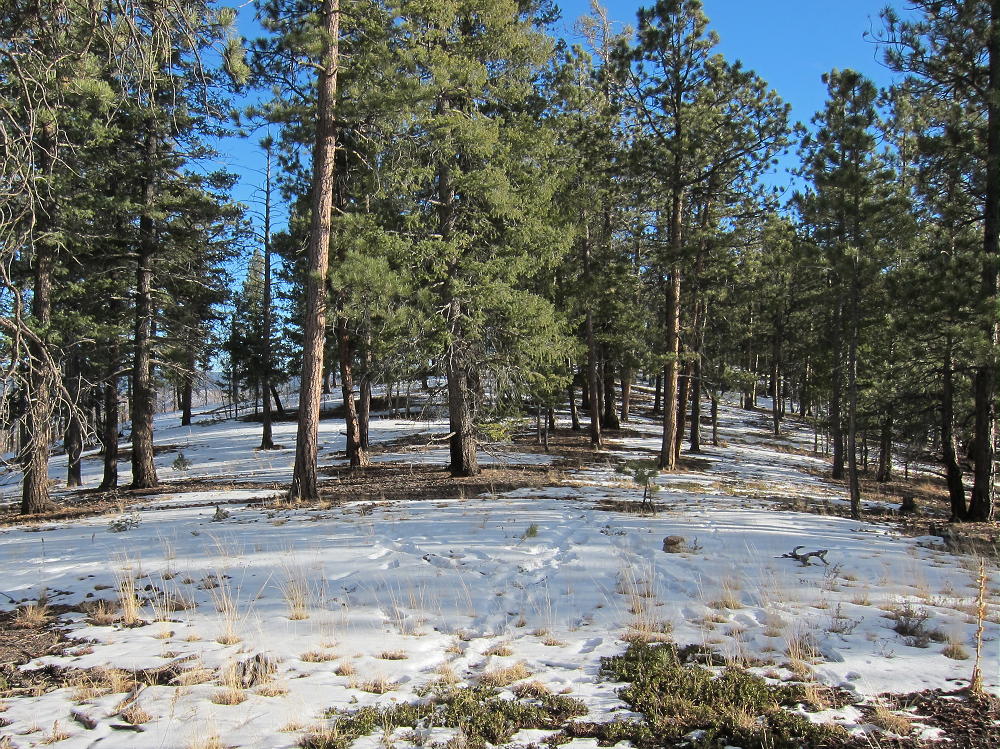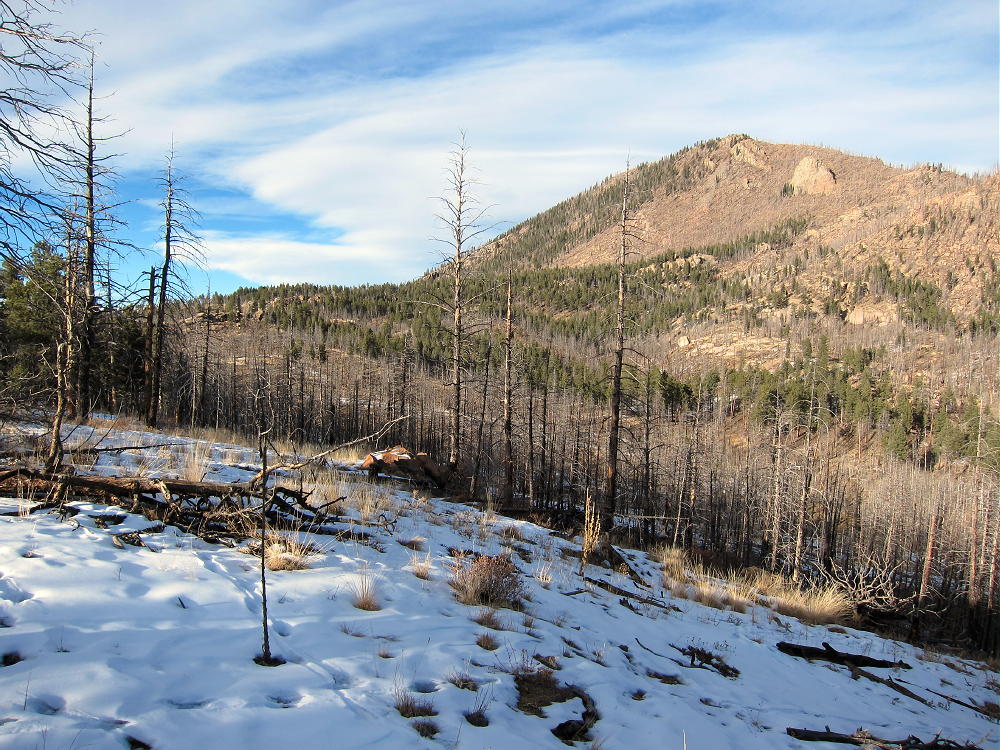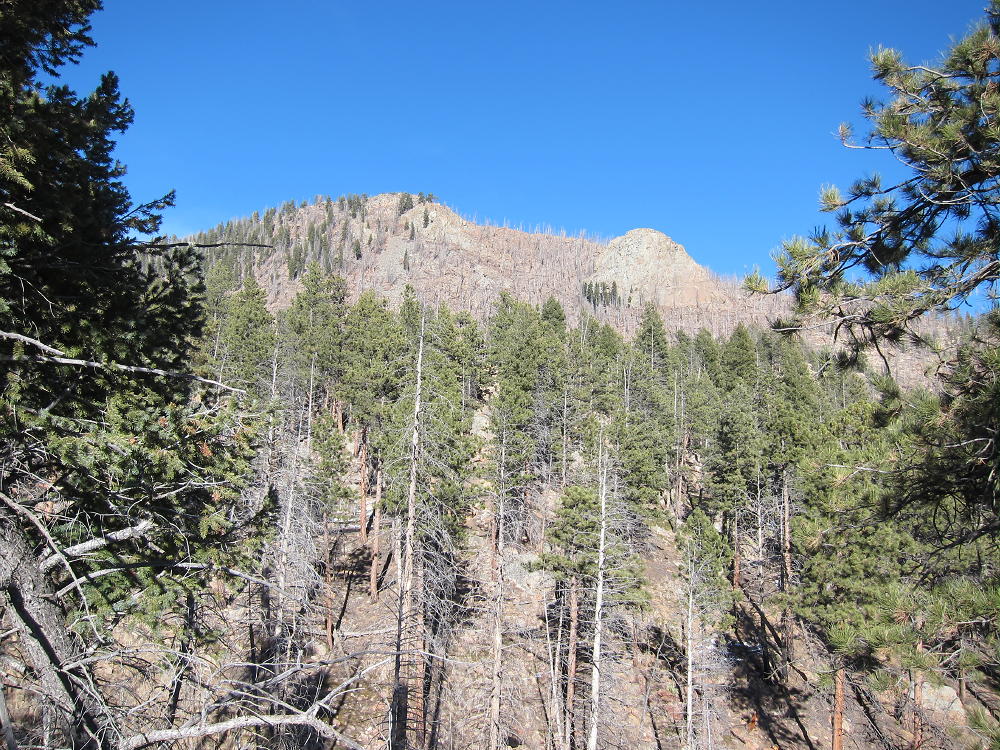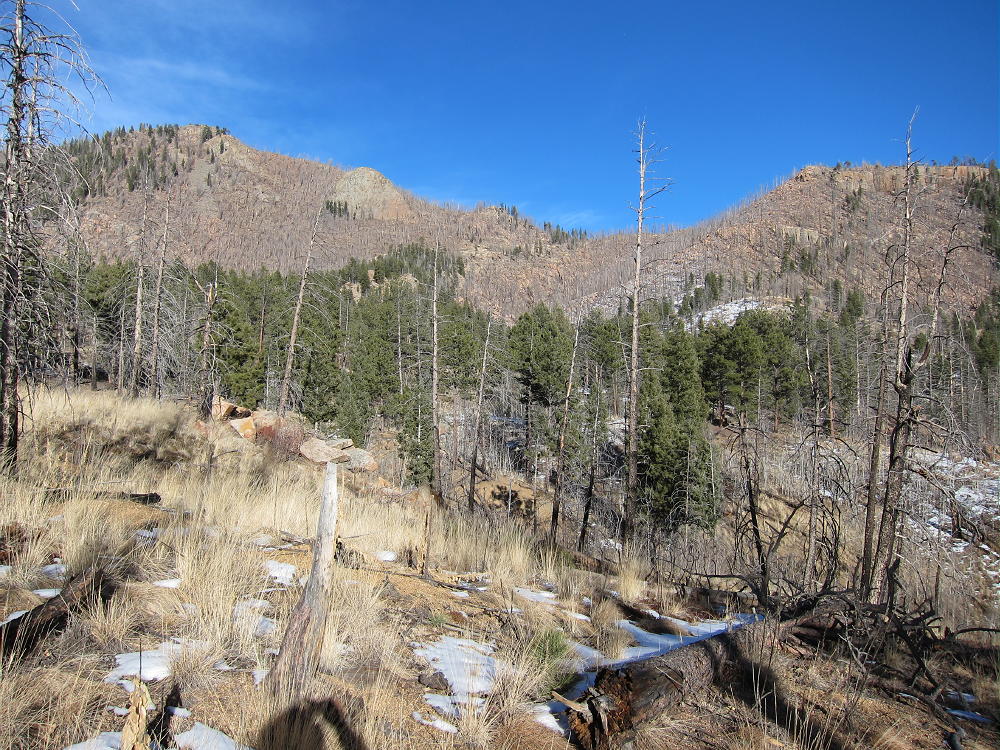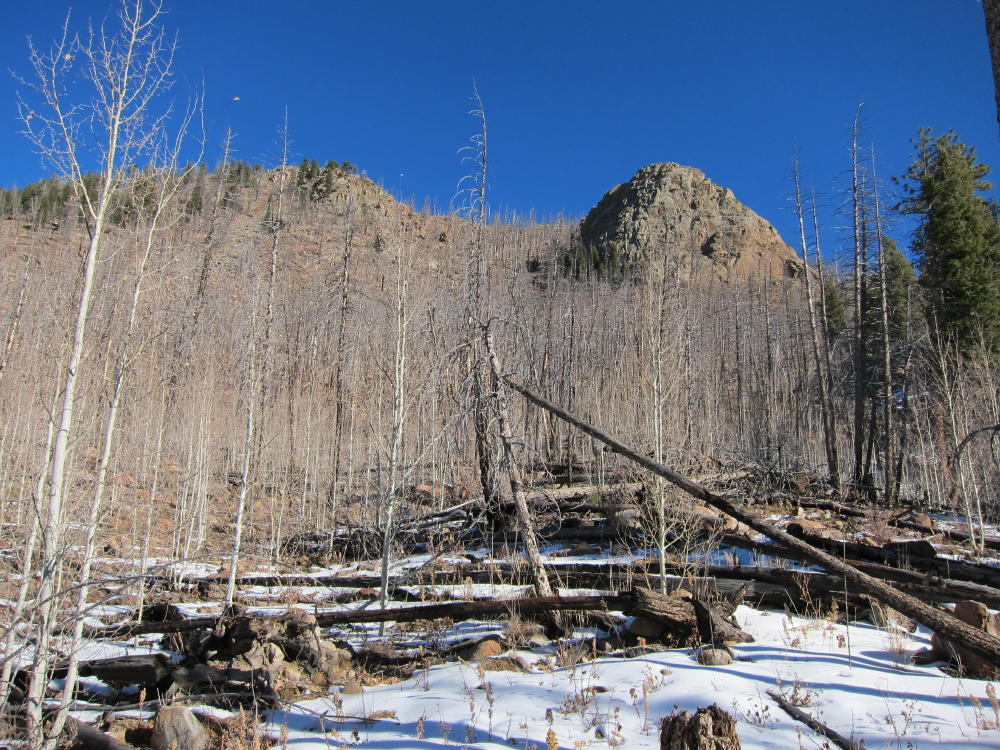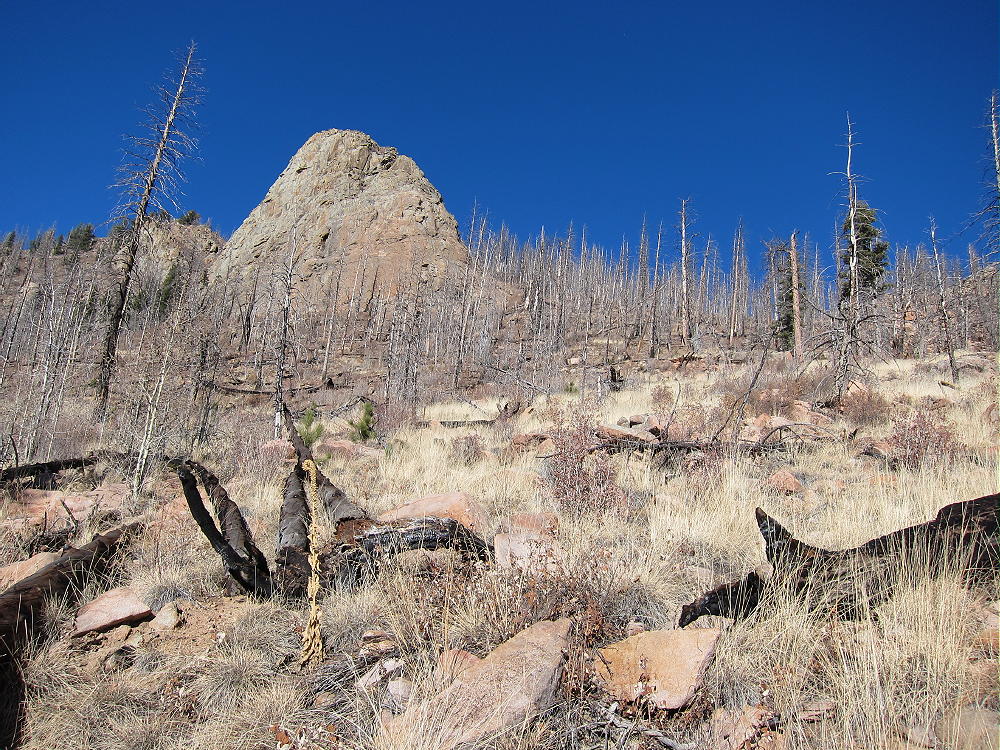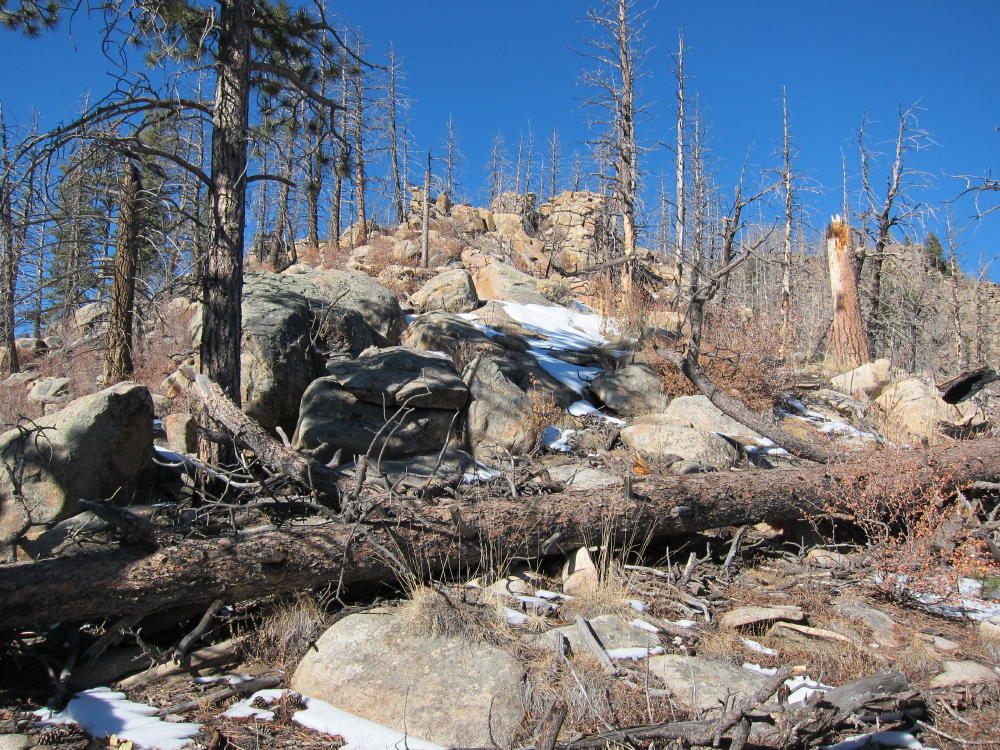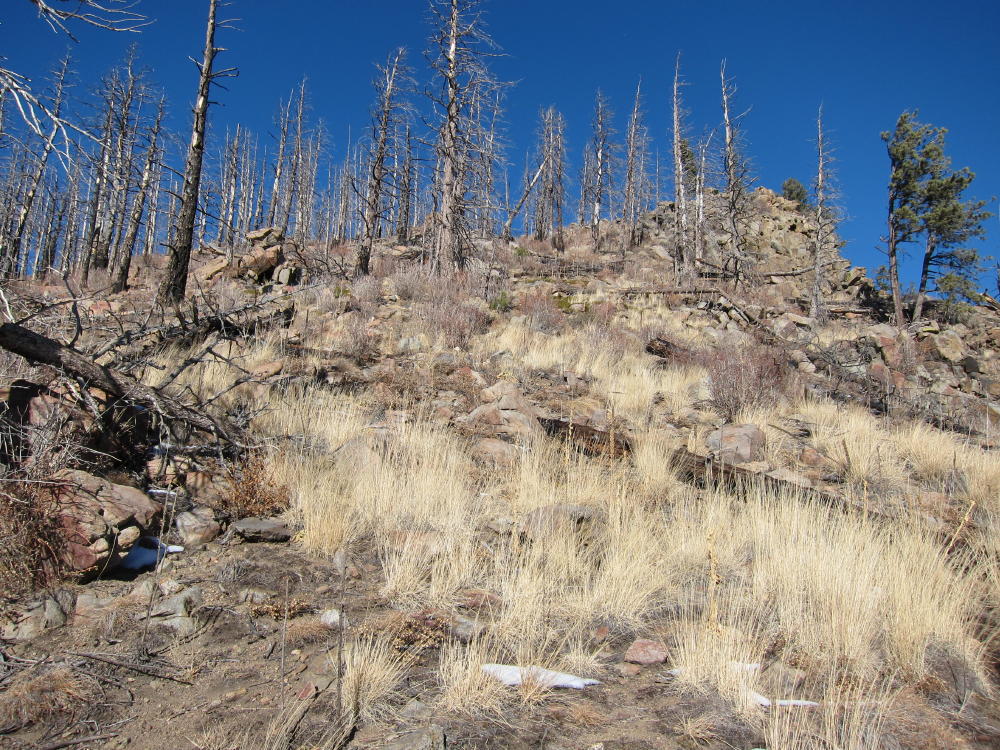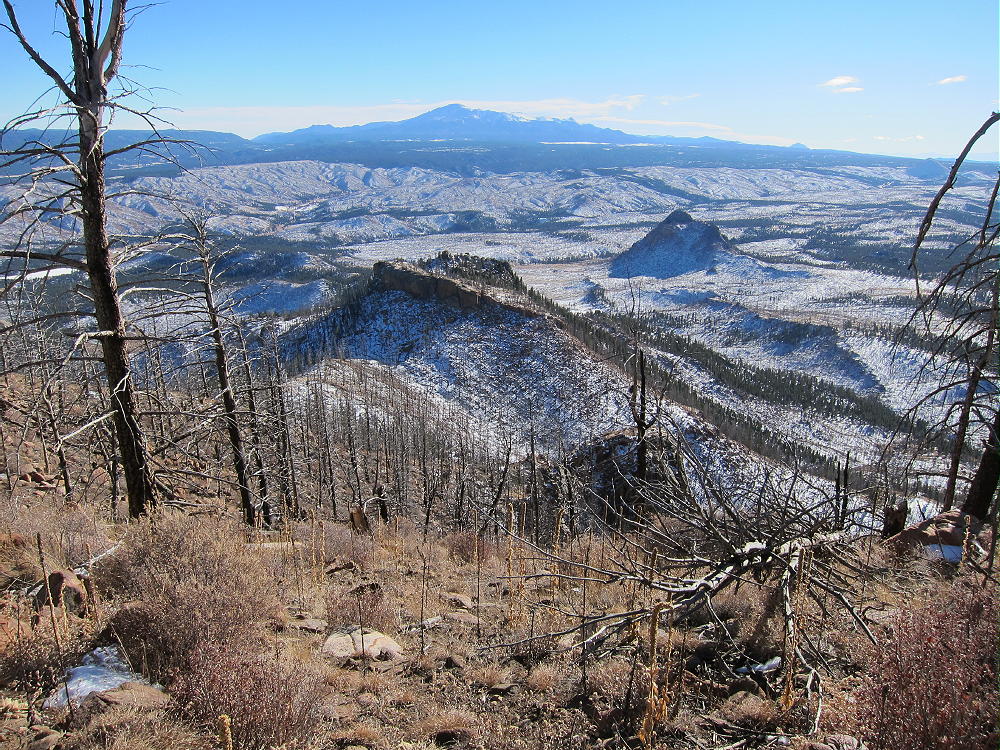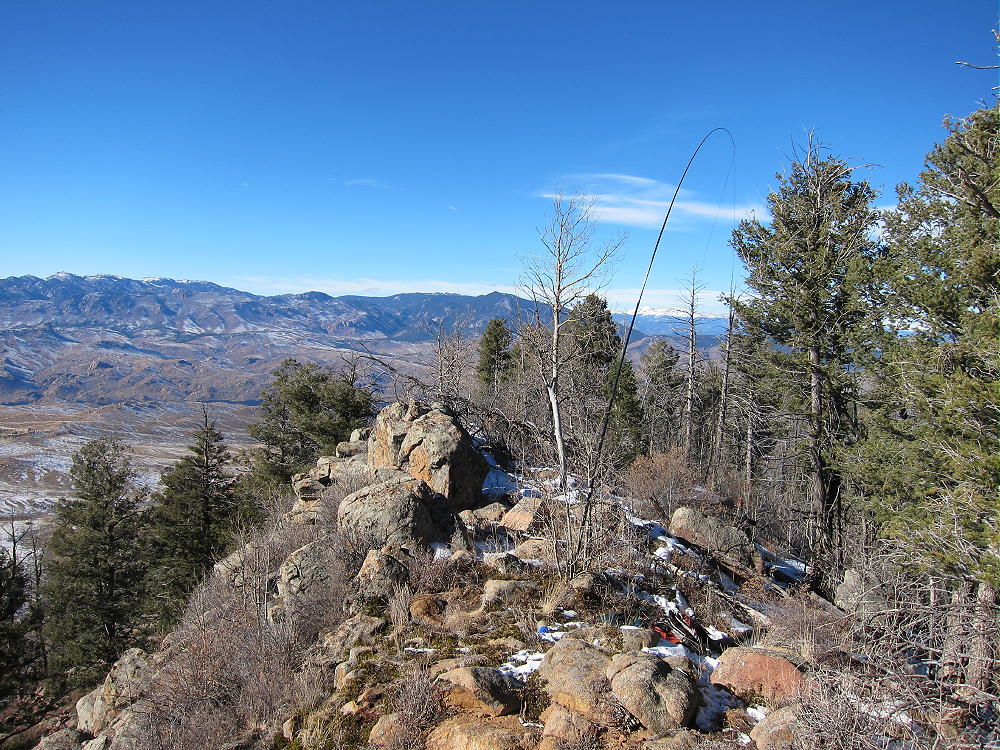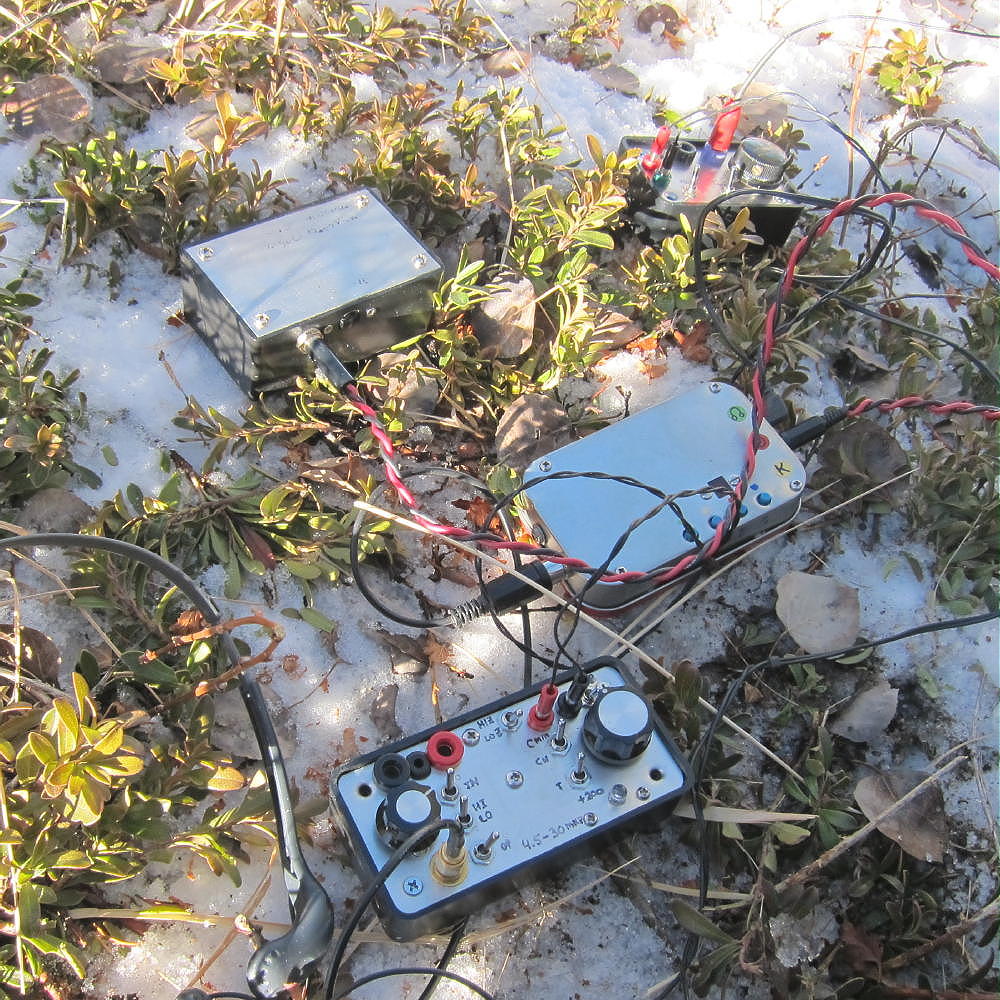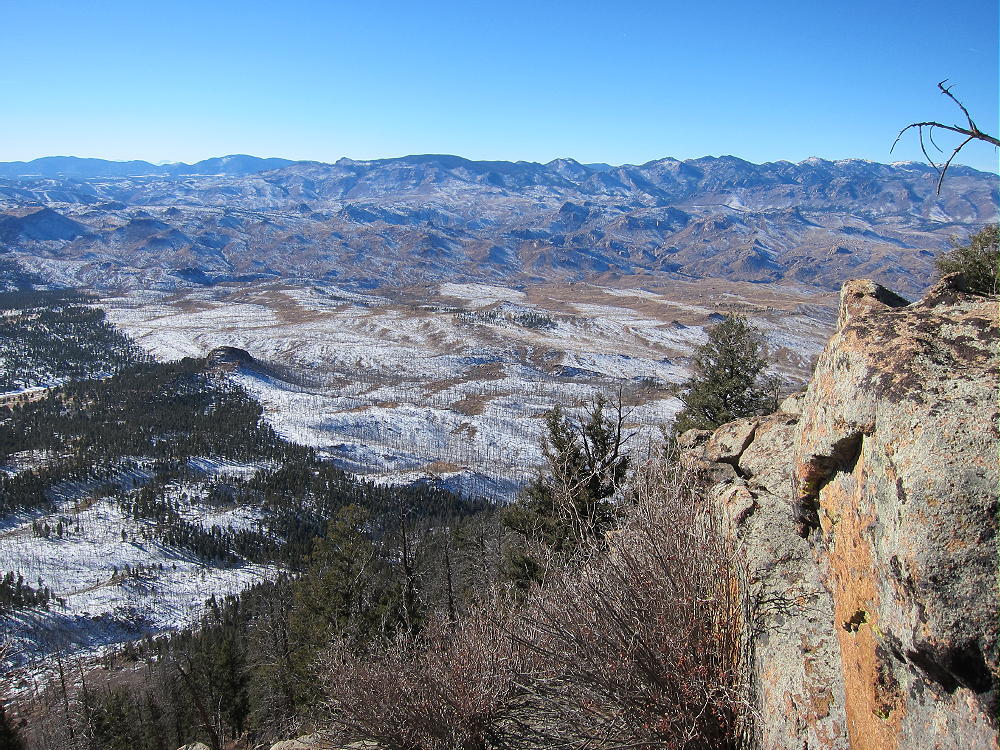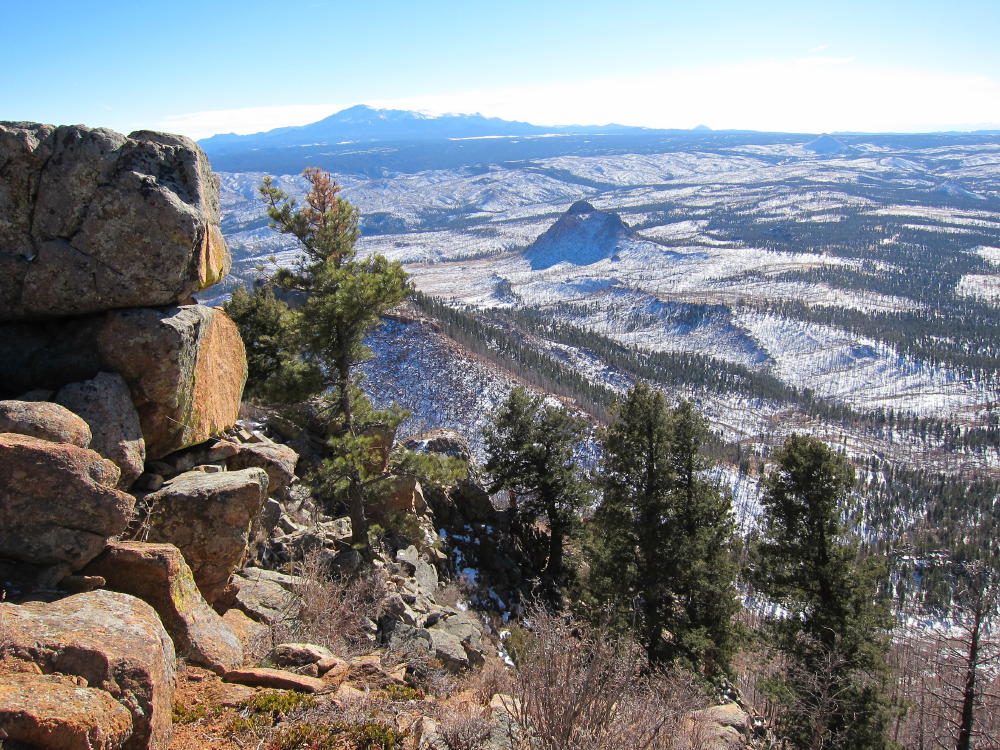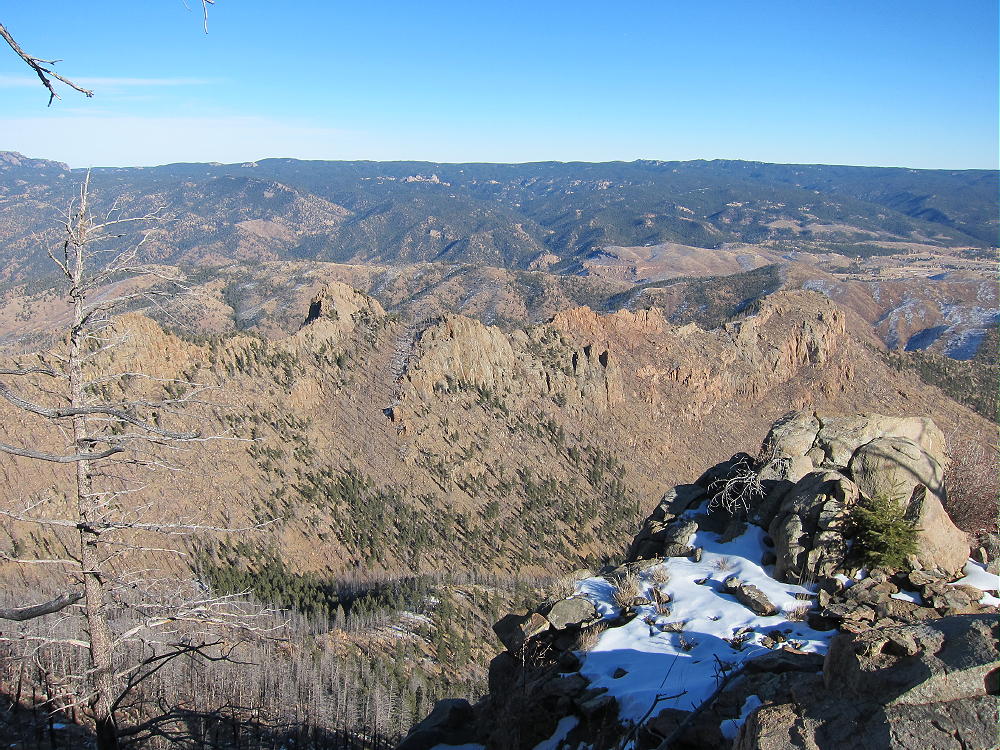W0C/FR-048 (Thunder Butte) – 2992 M / 9836 FT
Jan 03, 2014
by KX0R
Thunder Butte is a prominent mountain located in the Pike National Forest southwest of Deckers. It’s an interesting off-trail climb with convenient access and immense vistas – it’s also a great SOTA peak!
Get up early, drive west of Denver on Highway 285, and turn left (south) on Highway 126 at Pine Junction. Drive down through Pine, stay on 126 through Buffalo Creek, and continue south on the good paved road all the way to Deckers. Continue south from Deckers on paved Highway 67 for 9 miles to Westcreek. Turn right at Westcreek on unpaved Abbey Road, drop to Road 73 and turn south, go about ½ mile to the Volunteer Fire Station, and turn right – west – on Highway 68 (W Stump Road). Drive west 2 miles on this good dirt road, past a large rock formation called the Sheep Nose, and turn sharply right on marked 9-J Road.
(You can also drive up from Colorado Springs via Route 24 to Woodland Park, and then take Road 67 north to Westcreek.)
9-J is a maintained forest road. It was not gated on Jan 3, 2014 when I was there, and the snow had been recently plowed. I met a propane truck coming out when I was driving in, so some one lives up the road. There was no problem driving up about 1.3 miles to the marked parking area at the top of a ridge, west of Sheep Nose, where the road turns sharply west. Park here in the designated spot. A sign warns that this is a burn area, with possible hazards like falling trees, flash floods, and destroyed trails. This is a real fun place!
There is no trail-head sign or trail at the parking area. You can see Thunder Butte about 1.5 miles to the north. The route up to the summit is not difficult, and route-finding is easy if you’re prepared; however, it’s essential to study the topo map of this area before starting in. Take a compass, topo map, and perhaps a GPS unit. Note that it would be easier to go wrong on the return than on the ascent – be sure to look back every so often and to learn what the return route looks like.
Hike approximately north on the broad ridge-top from the parking area. This ridge heads roughly toward the summit, which is on the left side of the elevated part of the mountain you see. Stay on the ridge as it veers slightly east and west of north, while mostly climbing gradually. Follow this ridge for about 1-1/2 miles through a nice forested area that was spared by the Hayman Fire (that fire burned most of this region, over 135,000 acres, more than ten years ago). There may be a few cairns along the ridge, and there are sections where a faint trail is visible. The route I followed climbs up a faint trail section near the top of the ridge near various rocky outcrops, and then when the outcrops become obstacles, the route drops northeast a short distance and crosses a shallow gulch. This place is just before the whole landscape begins to get steeper to the north.
After crossing the small gulch, climb generally northeast, on an increasing grade, through the burned forest. The route heads up to the obvious saddle between the summit ridge and the sub-peak to the south. Stay north and above the valley that leads to the saddle – the valley is choked with bushes and trees. The route above ascends northeast through open, burned forest – there are bits of trail if you look – try to follow the natural route up to the saddle. Don’t try to climb up to the summit directly – just head over to the north part of the saddle, get on the summit ridge, and then climb on up to the top. Follow the narrow ridge, staying mostly on the top or west side, where there are bits of trail. Be sure to look down to the east, at the huge craggy ridge system below!
After about 300 vertical feet of climbing rocks and bare soil among dead trees on the summit ridge, you’ll reach a sub-peak; from here you can see the summit not far above – the final ascent is no problem. There’s no exposure on the class 2 summit ridge route, until you reach the top.
The summit is a small exposed rocky area, with an incredible view of Pikes Peak and the huge Hayman Burn to the south and west. There was a “register” in a plastic bottle down in the rocks when I was there. People do climb this remote peak – I saw fresh footprints in the snow when I was there, and another man reached the summit not long after I did. I noticed that Gerry and Jennifer Roach signed the register in 2009 – but there are not many names in the notepad.
The day I climbed Thunder Butte was abnormally warm for Jan 3. It was sunny, and it followed a warm dry spell with little snow. The temperature on top at 9836 feet was about 40 degrees. The south side of the mountain was mostly free of snow, but there were 4-6 inches of snow in the shade. On the narrow summit ridge it was windy, especially on the west edge. I was able to set up my activation on the ridge – this required stringing my 66 foot wire north along the ridge, across snowy rocks, and through bushes and small trees. I tied the 20 foot fiberglass pole to a small tree – then I found a dead aspen trunk and used it as a mast to raise the far end of my wire 10 feet above the ridge-top.
The whole time I couldn’t believe I was actually doing this on January 3. I never needed gloves the whole time I was on top, even though the wind was hissing across the summit cliffs! I set up my ATS-3B, resonated my homebrew high-Z tuner on 15M, matched up the main tuner, and called CQ on 21.062 – I was earlier than my alert time. After two or three calls, N1EU called with a big 599 signal from NY, and I knew it was going to happen! K6EL in CA was next, and then there was a big pile. After 15 Q’s on 15M, I retuned to 20M and worked 25 additional stations. Conditions were great on both bands! Since the 66 foot wire is 3/2 wave on 15M and a full wave on 20M, my high-Z tuner matched it quickly on both bands, with no counterpoise. Somehow the antenna stayed up, even though the pole and wire were both moving around with the wind gusts.
A few comments about propagation from Thunder Butte are in order. This mountain is in a remote part of the South Platte Canyon region, but at 9836 feet, I could see over the Rampart Range and into a small part of the South Denver area. I had solid 21 MHz direct signals from N0TA, up north in Louisville, and K0FNR, in Arvada. For HF, Thunder Butte is an almost perfect site, with huge prominence in all directions and no larger peaks for many miles. VHF/UHF propagation is probably limited by the Rampart Range to the east, as well as in other directions, though local coverage is likely excellent. The site is quiet, and there is little development in the area.
I recommend descending by the same route used for the ascent. Avoid going down into any valleys, except for the small gulch you crossed previously before starting to climb up toward the saddle. Hike out on the long ridge you came in on. Head toward the west (right) side of the Sheep Nose rock on the way out. Use a compass or GPS to make sure you backtrack accurately.
This could be an unpleasant hike in summer, with little shade, no water, and hot, bare ground. The peak is called Thunder Butte for good reason. Don’t test your luck on this summit if dark clouds approach!
One trip report I found warned about thorny bushes, but I didn’t have any problem with them. Most of the burned forest is open and easy to deal with. This should be a nice hike on a dry spring or fall day. Even though there’s no marked route, this ascent is relatively easy, with only 2.5 miles each way, and 1400 vertical feet of gain. The ridge route is easy and pleasant, better than many trails!
Thunder Butte is close enough to the Denver-Colorado Springs area that it should see more SOTA activations. The vast, unique view is both awesome and heartbreaking. With its south-facing route and good road access, this mountain is a SOTA Classic!
George Carey Fuller
KX0R
- Warning Sign at Thunder Butte “Trailhead” Parking
- Thunder Butte from the “Trailhead” Parking – the Broad Ridge Route
- Thunder Butte and Pikes Peak from Little Scraggy Peak
- Hiking Route to Thunder Butte along Broad Ridge
- Hike along Ridge Part Way to Thunder Butte
- Thunder Butte Summit from Ridge Route, about Halfway
- Thunder Butte Summit, Saddle, and Southern Sub-Peak
- Thunder Butte Route below the Saddle
- South Side of Thunder Butte from Burned Forest Route
- Thunder Butte Summit Ridge above Saddle
- Thunder Butte Summit Ridge
- View South from Thunder Butte Summit – Hayman Burn and Pikes Peak
- First SOTA Activation on Thunder Butte Summit – 66ft WIre on Black Widow Pole
- ATS-3B, Tuners, and Battery – 1st Activation of Thunder Butte
- View from Thunder Summit West to Lost Creek Wilderness
- View South from Thunder Butte Summit, across Hayman Burn to Pikes Peak
- Complex Ridge System SE Side of Thunder Butte
![]() !! WARNING !! There are old mountaineers, and
bold mountaineers... there are no old-bold mountaineers.
Hiking and mountain climbing are potentially hazardous activities particularly in Colorado with its extreme elevations. I am not accepting responsibility for any death or injury resulting from activations based on my trip reports. Proper training, experience, and personal capability assessment is required - enjoy!
!! WARNING !! There are old mountaineers, and
bold mountaineers... there are no old-bold mountaineers.
Hiking and mountain climbing are potentially hazardous activities particularly in Colorado with its extreme elevations. I am not accepting responsibility for any death or injury resulting from activations based on my trip reports. Proper training, experience, and personal capability assessment is required - enjoy!











